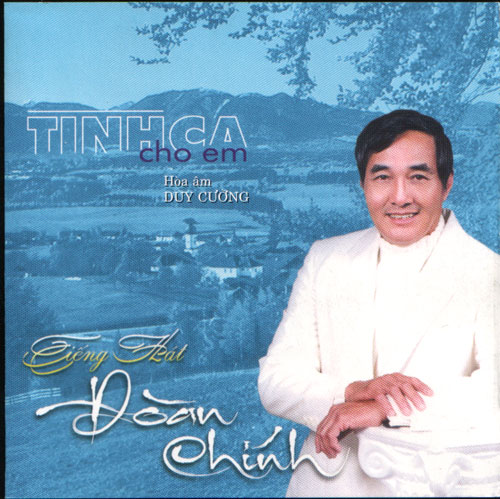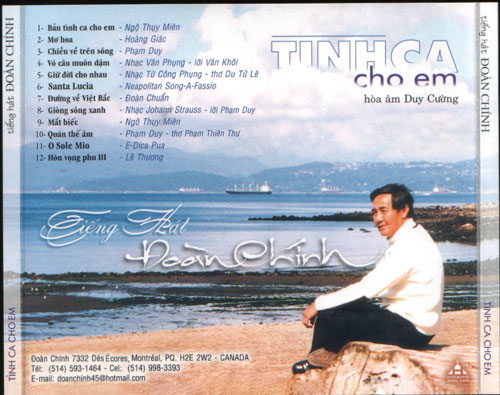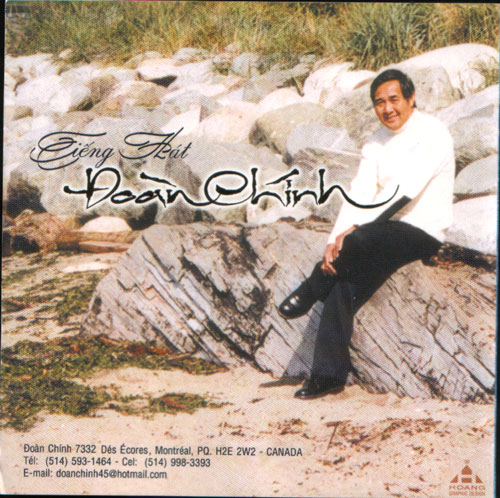Tình Ca Cho Em
- Liên lạc:
Đoàn Chính
7332 Dés Écores, Montréal, PQ. H2E 2W2 - CANADA - phone: 514-593-1464
email: doanhuongt@yahoo.ca
(thân phụ của Đoàn Chính là Đoàn Chuẩn)
sách nhạc Những Dòng Nhạc Mùa Thu




Chiều Về Trên Sông
nhạc Phạm Duy - Đoàn Chính trình bày
Chiều buông trên giòng sông Cửu Long
Như một cơn ước mong, ơi chiều
Về đâu ơi hàng cây gỗ rong
Nghiêng mình trên sóng sông yêu kiều
Buồn tôi không vì sao bỗng dưng
Theo đò ngang quá giang thương chiều
Bởi vì thương nhiều nên nhớ (ơ) tình yêu
Bởi vì đời còn nhiều khi là mơ
Bởi vì đời còn nhiều khi thành thơ
Có khi vui lững lờ
Có khi tuôn sầu u
Bởi vì chiều buồn chiều về giòng sông
Bởi vì tình đời nào chỉ thù oán
Hãy cất tiếng ca cho đời thêm (ý) buồn
Hãy cất tiếng ca cho lòng thôi khô héo
Chiều buông trên giòng sông cuốn mau
Thương đời thương lẫn nhau trong chiều
Về đây bọt bèo muôn khắp nơi
Vui buồn cho có đôi không nhiều
Ngày mai sông về quê mến yêu
Cho trùng dương cũng theo hương chiều
Bể sầu không nhiều nhưng cũng (ư) đủ yêu.
1957
Đường Về Việt Bắc
- nhạc Đoàn Chuẩn - Từ Linh
- Đoàn Chính trình bày
Chiều nào áo tím nhiều quá
Lòng thấy rộn ràng nhớ...nguời
Ðường về Việt Bắc xa cách mây
Nhìn về đường lối muôn khó khăn
Ðây núi cao, đây suối sâu
Ðây lá xanh như ngàn sương
Ðường về ngập gió tha phương
Tiếc đời gấm hoa ta đành quên...
màu sắc núi rừng
Qua bao rừng núi anh về đây
Nhớ nhau từng phút, yêu từng giây
Ðường về Việt Bắc xa xôi... rừng núi
Nâng phím tơ lên mấy cung... lả lơi
Ðường về Việt Bắc xa xa... núi... đồi
Santa Lucia
Đoàn Chính trình bày
Santa Lucia is a traditional Neapolitan song. It was transcribed by Teodoro
Cottrau (1827–1879) and published by the Cottrau firm, as a "barcarolla", at
Naples in 1849. Cottrau translated it from Napuletano into Italian during
the first stage of the Risorgimento, the first Neapolitan song to be given
Italian lyrics. Its transcriber, who is very often credited as its composer,
was the son of the French-born Italian composer and collector of songs
Guillaume Louis Cottrau (1797–1847).
The Neapolitan lyrics of "Santa Lucia" celebrate the picturesque waterfront
district, Borgo Santa Lucia, in the Bay of Naples, in the invitation of a
boatman to take a turn in his boat, the better to enjoy the cool of the
evening.
"O dolce Napoli,
o suol beato,
Ove sorridere
Volle il Creato"
Tu sei l'impero
Di armonia!
Santa Lucia! Santa Lucia"
In the United States, an early edition of the song, with an English
translation by Thomas Oliphant, was published by M. McCaffrey, Baltimore.
Perhaps the definitive 20th century recording of the song was that of Enrico
Caruso, the great Neapolitan opera singer.
The song has also been recorded by Elvis Presley on the 1965 album Elvis for
Everyone.
In Sweden, Denmark and Norway, "Santa Lucia" has been given various lyrics
to accommodate it to the winter-light festival of Saint Lucy, at the darkest
time of the year. The three most famous lyrics versions in Swedish are
Luciasången, aka Sankta Lucia, ljusklara hägring (“Saint Lucy, bright
illusion”), Natten går tunga fjät (“The night walks with heavy steps”) and
the 1970s "Kindergarten" version Ute är mörkt och kallt (“Outside it’s dark
and cold”).
In the Czech Republic (or rather former Czechoslovakia) it was made famous
with the words Krásná je Neapol sung by Waldemar Matuška.
References -
della Corte, A.; G. M. Gatti (1925). Dizionario di Musica. Turin.
Naples is described beautifully in this song as, "suolo beato, ove sorridere
volle il Creato" (holy soil, smiled upon by the Creator). The Santa Lucia
quarter is called "impero dell'armonia" (the empire of harmony).
http://en.wikipedia.org/wiki/Santa_Lucia